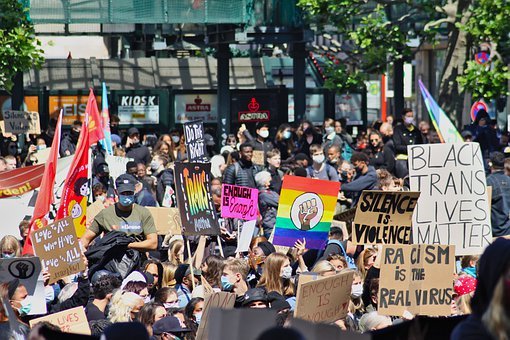BLM: America’s Homegrown Marxism
A new book exposes the ideological wellsprings of the Black Lives Matter movement.
BLM: The Making of a New Marxist Revolution, by Mike Gonzalez (Encounter Books, 2021), 234 pages.
A running joke on the climate-skeptic right depicts environmentalists as political watermelons—green on the outside, red on the inside. After the rampant rioting and looting of two summers ago that used George Floyd’s death as a pretext, it’s high time the culprits got their own fruit analogy. Per Mike Gonzalez’s latest book, BLM: The Making of a New Marxist Revolution (2021), the namesake group resembles a fig—black on the outside, red on the inside. For all its outward pretension of caring for the plight of black Americans, the movement’s inner drive has proven to be the overhaul of American society along Marxist lines.
Much like his prior bestseller The Plot to Change America (2020), Gonzalez’s book argues the simple point that today’s far-left social movements didn’t come out of anywhere—they’ve only been portrayed as such by a pliant media. For the lay observer, Black Lives Matter (BLM) may seem like a discrete response to the killings of Trayvon Martin, Michael Brown, and George Floyd, one limited to advocating for the rooting out of racial inequities from policing and the criminal justice system. Gonzalez proves beyond doubt that this is not the case. BLM is but the latest iteration of a long effort, first undertaken by the Soviet Union, to whip up racial animus and urban unrest for the benefit of Marxist causes. “Behind the prison and police reform façade,” he writes, “lies a deep ideological commitment to abandoning our free-market and liberal democratic system and to remaking America along Marxist lines.” The reason this effort has fared far better than in the 1920s and 1960s is owed to the media’s refusal to cover these groups critically and to the state of ritualistic self-flagellation into which the liberal establishment has been cowed since the killing of George Floyd.
But BLM can’t be reduced to its interpretation of the Founding, lest we overlook the forward-looking elements of its ideology. Gonzalez proceeds to sketch a history of the links between communism and parts of the African American community beginning in the mid-19th century, when the Marxist objection to American capitalism wasn’t so much slavery as wage slavery—namely, industrial employment. As soon as it formed, the Soviet Union began its own efforts to convert black Americans to communism through figures from the so-called Harlem Renaissance of black letters, such as Lanston Hughes, W.E.B. Du Bois and Claude McKay. The Soviets’ ambition to destabilize America by setting up “a separate Negro state” from which to launch a revolution across the rest of the country, however, did not align with Marcus Garvey, the leader of the separatist, pan-Africanist wing of the black movement working towards a similar end. In fact, Garvey would remain a staunch anti-communist all his life. “Though black intellectuals may have fallen for the siren song of communism,” Gonzalez writes, “rank and file black Americans saw through Moscow’s actions and said no, thanks.”
But the mix of Marxism and racial identitarianism would come to a head in the 1960s, when “the core principle of the civil rights era—that discrimination on the basis of race was evil—was almost instantly reversed.” A new generation of black leaders including Malcolm X, Stokey Carmichael, Angela Davis, and Assata Shakur would break with the civil rights movement’s incrementalist methods and color-blind policies, instead deeming white Americans—and thus America at large—inherently evil. This, in Gonzalez’s telling, is precisely the generation that trained, groomed, and eventually passed the torch to today’s BLM leaders, people such as Opal Tometi, Patrice Cullors, Alicia Garza, and Melina Abdullah. “Even before they created the hashtag expression #BlackLivesMatter in 2013 that later became an empire of revolutionary organizations around the world,” Gonzalez writes, “they belonged or associated with an interlacing web of socialist groups that have been trying to overthrow the American system for decades.”
Since emerging as an online rallying cry in the wake of Trayvon Martin’s death, BLM has been beefed up with considerable organizing muscle through the creation of the Movement for Black Lives (M4BL) and BLM Global Network Foundation, “both radical, anti-capitalist organizations that seek a root-and-branch change of the way the U.S. is constituted.” In 2020, this network was further ramped up through the creation of a SuperPAC—meaning that BLM can fund candidates and lobby for bills—all thanks to the support of an interlocking web of philanthropic organizations—George Soros’s Open Society Foundations, Susan Rosenberg’s Thousand Currents, Drummond Pike’s Tides Foundation, and the Buffett family’s NoVo Foundation. Through its lobbying of Congress and its funding of soft-on-crime district attorney races, BLM has been able to pressure the FBI out of investigating violence committed by what it calls Black Identity Extremists (BIEs), and effectively lessen the punishment for the lawlessness that dovetails with BLM.
For depicting such a despairing phenomenon, the book ends on a remarkably hopeful note. Gonzalez hopes that the moral panic about the state of America’s race relations that so bedevils our elites can be stemmed and eventually rolled back through a combination of reasoned reforms making police departments more accountable, cold-headed books like his proving that the impression of a “carceral state” up against black Americans is an illusion, and the kind of civil courage on display in the grassroots effort to stop critical race theory continuing. Thirty years ago, America led the world’s defeat of communism. With enough facts and spine, its homegrown variant can be defeated again.
*****
This article was published on November 13, 2021, and is reproduced with permission from The American Conservative.



